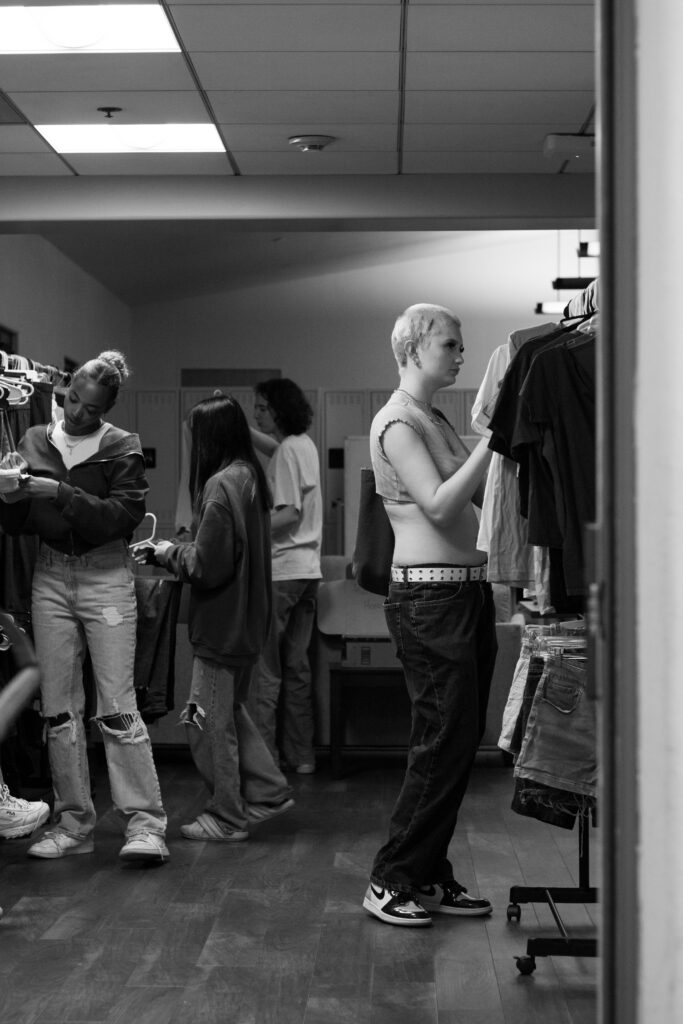Juliette Des Rosiers ’26
Copy Editor Intern
There is a special pride in graciously accepting a compliment on an outfit with, “thank you, it’s thrifted.” Looking to nurture Scripps’s thrift gods, the Scripps Student Sustainability Committee started the Scripps Free Closet sustainability initiative. Yet, this project would be more impactful if it promoted a holistic, community-based approach to sustainability.
When the climate crisis time-bomb is ticking away, we cannot fall back on the comfortable reduce-reuse-recycle rhetoric of the 20th century. I am not here to argue that reducing clothing waste is not a worthwhile initiative when 17 million tons of textile waste is accumulated in the United States each year. However, I believe a Free Closet initiative can have a greater impact than simply collecting and trading used clothes.
The Free Closet aims to reduce textile waste by encouraging students to donate their clothes and shop from those of their peers. It opens every Tuesday in the Student Union from 7-9 p.m.
The Free Closet promotes sustainability by disrupting the consumer chain associated with cheap, exploitative fashion. Instead of throwing away their used clothes, Scrippsies are encouraged to donate their clothes and reroute them to a sustainable space. Students have equal opportunity to take advantage of free clothes rather than purchasing new pieces from brands that often have shameful environmental and labor practices.
The initiative achieves its sustainability goals by reducing waste and improving Scrippsies’ carbon footprint. I believe, though, that it could expand to support the communities around Claremont similar to other sustainability initiatives at Scripps.
On Instagram, the Scripps Student Sustainability Committee shared that they have redistributed 130 garments of clothing back into the Scripps community. However, the implication of ”redistribution” reinforces my main qualm with the Free Closet. At an elite institution that provides its students with a wide array of resources, this initiative is not redistribution, but simply keeping the same resources within the same group.
At Scripps College, students are taught about how institutions, both public and private, fail the people they are supposedly made to serve. Our Race & Ethnic and Women & Gender Studies General Education requirements exist to prioritize students interacting with critiques of these systems, as well as learning how to dismantle or improve them. I believe that this knowledge is a privilege in itself, since we have the luxury of learning about it from our classes rather than lived experience. Therefore, we must take action and apply the critical teachings of these classes.
It is our responsibility to champion sustainability beyond simply reducing waste and examine how sustainability interacts with systems of power. Luckily, many of the initiatives fostered by the Scripps Student Sustainability Committee already recognize and implement these values of environmental justice and critical sustainability. For example, many environmental justice groups highlight the link between food deserts, industrial farming, poverty, and obesity. The Scripps Student Sustainability Committee sent a message to the school community on April 23 announcing their new initiative to reroute Malott’s food waste to a community garden in Ontario.
After successfully adding compost bins to Malott Dining Hall, the Scripps Student Sustainability Committee decided to take the initiative one positive step further. Instead of the compost waste from Malott being sent to a private, industrial processing facility, it will go to Huerta de Valle, a community farm that is dedicated to environmental justice education and combating unequal access to healthy food. This is a wonderful example of a Scripps initiative that improves sustainability on-campus and supports an invaluable organization to “form sustainable connections with the broader Inland Empire community, where we provide them with resources instead of extracting them,” according to the email.
Another example of a Sustainability Committee initiative that will have a positive social impact beyond campus is the in-the-works proposal to provide zero-waste alternatives for laundry detergent on campus. The hope is to partner with Generation Conscious, “a BIPOC-owned environmental justice startup devoted to providing college students with access to zero-waste, low-carbon laundry detergent”, according to a SASsy Newsletter announcement in early March. This initiative would provide students with a free, accessible, zero-waste detergent while simultaneously supporting the voices and initiatives of BIPOC entrepreneurs who are underrepresented in STEM policy fields.
Similar to the action taken with the Malott food waste or the piloted zero-waste laundry detergent, I hope the Scripps Student Sustainability Committee can also take its Free Closet initiative one positive step further. Collecting clothes prevents single-use consumerism and disrupts the supply chain that contributes to textile waste. However, could these clothes benefit someone else?
I believe that there is a lot of value in supporting local organizations such as social justice initiatives or shelters that also often encounter obstacles to accessing resources and funds. These actions mean more than simply donating to Goodwill or Salvation Army, as you are supporting those in your local community rather than large, impersonal national or international organizations that can be less responsible and transparent.
Therefore, I encourage the Scripps Student Sustainability Community to consider expanding the Free Closet to include a clothing drive component that donates items to local shelters for women and gender-queer persons. This addition could work in tandem with the current, fruitful initiative and educate Scripps students on a holistic, justice-oriented approach to sustainability.
These donation locations could include the Pomona Pride Center, Crossroads Inc. in Claremont which supports previously incarcerated women, the Hope for Home Center in Pomona, or The House of Ruth in Pomona which shelters victims of domestic violence. Clothing that is not accepted to these shelters could be sold to Deelux or on-campus and the proceeds donated to these local organizations. Additionally, appropriate clothing could be given to the Queer Resource Center communal closet at Pomona College that promotes LBGTQ+ equity.
I do believe Free Closet does provide the opportunity for free clothes equally across the student body, a benefit that should not be eradicated. I also believe the Sustainability Committee can add to the Free Closet to support surrounding communities in the inland empire who have less resources than Scripps and transform the already beneficial project into something with greater impact. The committee can promote sustainability beyond composting, recycling, and rerouting clothes from landfills, similar to how other Committee sustainability initiatives expand beyond campus.
Image Source: Ellen Hu ’24





